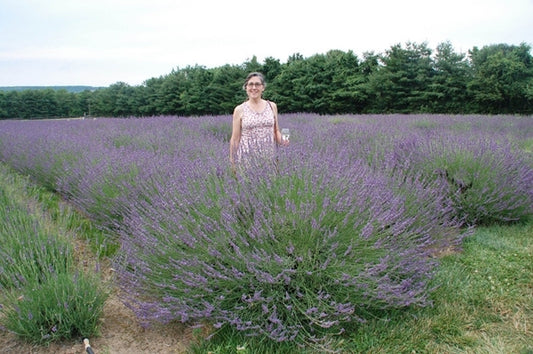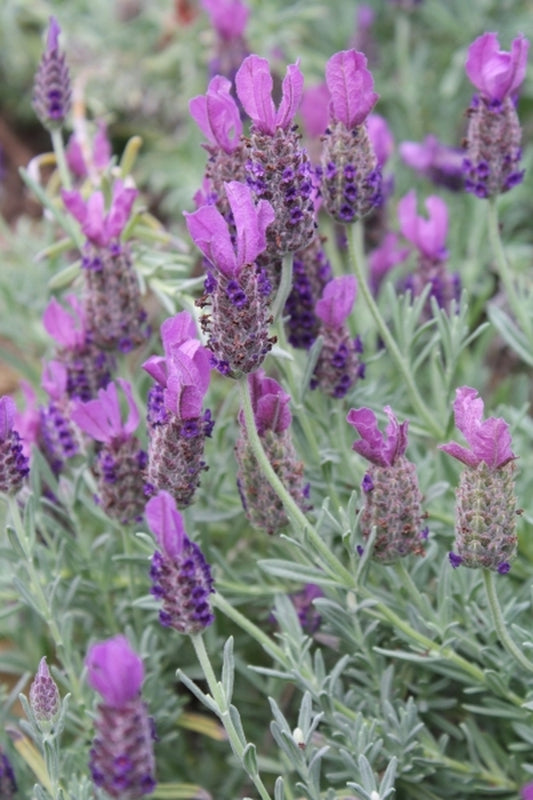Lavandula has one other trick up its sleeve. It is a fantastic ornamental plant. In addition to its wonderful scent and colorful flowers, Lavandula plants feature attractive silvery leaves and are drought-tolerant.
-
Lavandula x intermedia 'Phenomenal' PP 24,193
Item #: 6216
Zones: 4a to 7b, at least
Dormancy: Evergreen
Height: 30" tall
Culture: Sun
Origin: Hybrid
Pot Size: 3.5" pot (24 fl. oz/0.7 L)
Regular price $22.00Regular priceUnit price per -
Lavandula stoechas 'Anouk' PP 16,685
Item #: 8236
Zones: 7b to 10b, possibly colder
Dormancy: Evergreen
Height: 24" tall
Culture: Sun
Origin: Spain
Pot Size: 3.5" pot (24 fl. oz/0.7 L)
Regular price $22.00Regular priceUnit price per
More Information About Lavandula
Lavandula, commonly known as lavender, is a genus of 40 wild species plus a dozen or more hybrids and hundreds of named cultivars that are mint relatives. Lavender's claim to fame is the intoxicating aroma of the leaves and flower buds.
Common Uses for Lavender Plants
Plants in the genus Lavandula are distributed natively from southern Europe into Africa and east from the Arabian peninsula all the way to India, but it is cultivated by humans all over the world. One whiff of the essential oils of a lavender plant (called lavandulin) and you will understand why. The odor is pleasant, relaxing, and is known to cure headaches and repel mosquitos. In addition, lavender oil is anti-inflammatory and antiseptic. Because of this, oil of lavender can be found in thousands of products from soaps to perfumes, skin creams, potpourri, air fresheners, aromatherapy pillows, sachets and a myriad of other scented goodies. Lavender oil is also added to syrup, cheese, milk, baked goods, tea, desserts and is a component of the "herbes de Provence" herb blend used in gourmet cooking. Humans have been cultivating lavender since Roman times for this essential oil. Although all lavandula species are pleasantly fragrant, it is English lavender, Lavandula angustifolia, that is considered to have the best scent.
Lavender also refers to a color...a pale blue-purple shade modeled after the color of lavandula flowers. Like the scent, the color is associated with relaxation and is very popular in clothing, interior decorating, and paints/dyes. It is worth noting, though, that some lavandula flowers deviate from this hue and can be pink, blue, purple or white.
If that weren't enough, lavandula has one other trick up its sleeve. It is a fantastic ornamental plant. In addition to its wonderful scent and colorful flowers, lavandula plants feature attractive silvery leaves (due to the fine hairs that contain the essential oils) and are drought-tolerant.
Types of Lavender Plants
Several popular types of Lavandula for gardens are:
- Spanish Lavender (Lavandula stoechas, L. lanata, or L. dentata)
- English Lavender (Lavandula angustifolia)
- French Lavender (L. stoechas or L. dentata)
- Dutch Lavender (Lavandula x intermedia, a cross between L. angustifolia and L. latifolia)
- Portuguese Lavender (Lavandula latifolia) whose scent is a little more camphor-like or turpentine-like than English lavender.
As you can see, these common terms are imprecise and overlapping so the educated "lavandulist" should use the scientific names.
Lavender Plant Care
Lavender prefers full sun and well-drained, sandy soil that is neutral or alkaline. Water retaining soils tend to promote root rot and even thick layers of mulch around the base of the plants can cause rot. It works great in xeric gardens, on slopes, and in rocky soils and rock gardens. Lavender flowers are small but are produced in dense clusters (inflorescences) on the tips of the flower stalk. Not only are these flowers beautiful, but they attract bees and butterflies. Try pairing lavender with other fragrant plants like Aloysia, Buddleia, Dianthus or other silver-leaved or dark-leaved plants like Achillea, Agave, Cynara, Dicliptera, Glaucium, Othonna, Canna, Colocasia, Dahlia, Euphorbia or Sedum.
The name Lavandula is derived from the Latin word "lavar" for "to wash" because in the days before showers and commercial soaps, people anointed their bodies with lavender oil to clean themselves and to smell fresh. When you are ready to buy lavandula for your garden, check out our online list of lavandula for sale.



